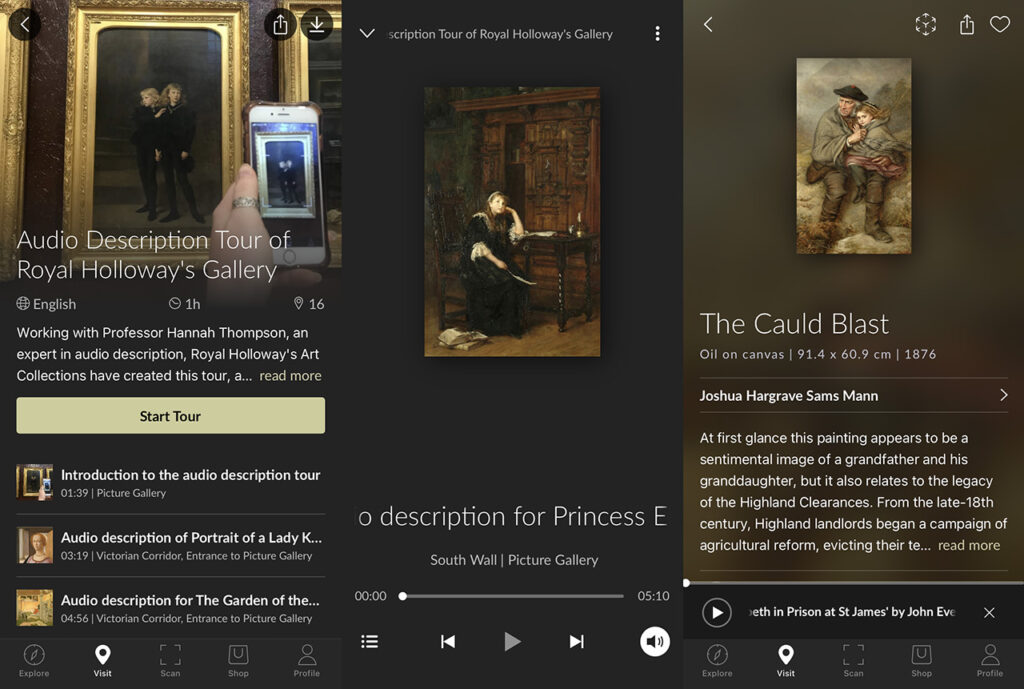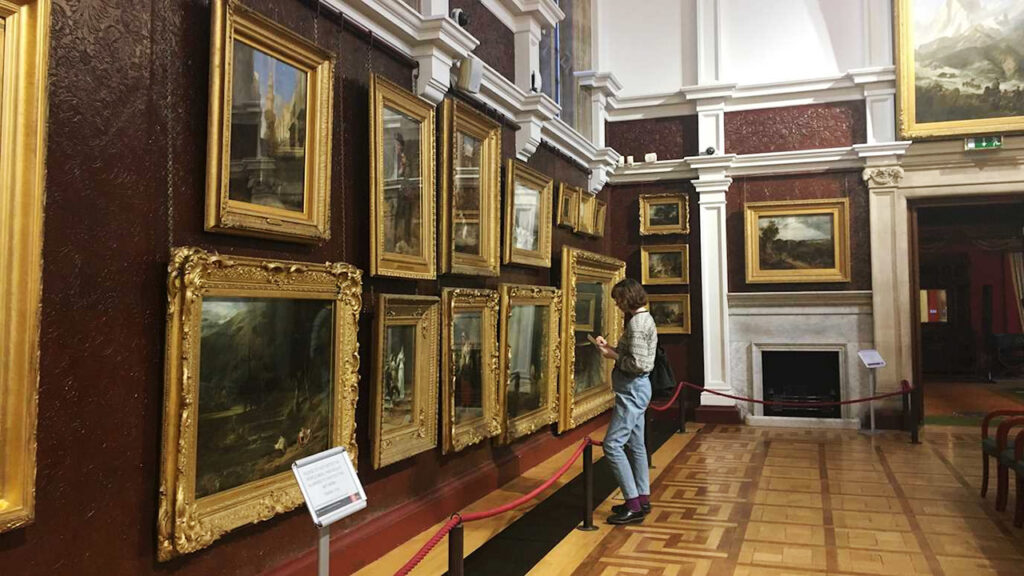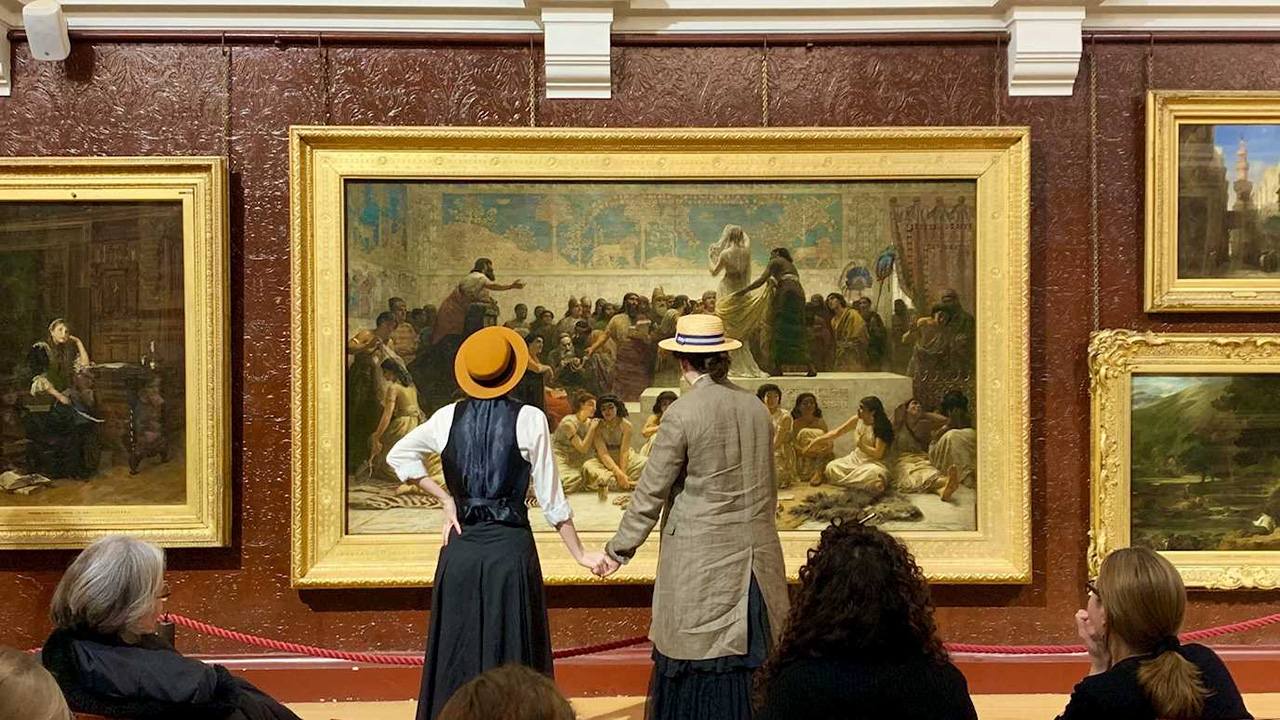Following the museum sector’s year of accelerated digital transformation, Smartify, in collaboration with Jing Culture & Commerce, presents a guest series spotlighting strategies that cultural institutions can leverage to expand their outreach and enrich their storytelling. Find more from the series here.
This summer, the Royal Holloway Picture Gallery released a unique audio tour on Smartify, offering an innovative take on the traditional “audio description” for partially blind visitors, aimed at increasing access to its collection. Rather than produce a guide that dryly describes artworks, the team at Royal Holloway worked with partially blind participants, volunteers, and gallery staff to create an audio experience that is a work of art in itself.
Smartify recently caught up with Professor Hannah Thompson, an expert in “blindness gain” at the Royal Holloway University of London, to learn about the team’s experience creating the audio guide.
Could you start by telling us a little about the tour and your goals in creating it?
We wanted to make a tour of the picture gallery that was accessible to blind and partially blind people, but we also wanted to involve a lot of the college community in the tour and we didn’t really have any budget to pay a professional audio describer. I decided to experiment with some different ways that I’ve been thinking about audio description. Rather than giving listeners an objective sense of a painting, I wanted them to feel like they were in the gallery themselves hearing different voices and different approaches to the paintings.
We recruited volunteers and told them a little bit about what I call “creative audio description,” which involves embracing your own position as a viewer — what is it in the painting that really speaks to you? Why do you feel a particular connection to the painting? What makes you want to look at it? — rather than describing it in a kind of precise, technical or mathematical way. I wanted to create descriptions that had an aesthetic side to them rather like the art itself. Every volunteer chose a painting and they came up with their own description of it, which we recorded and that made up the tour.

Royal Holloway’s audio descriptive tour covers 15 paintings including “Princess Elizabeth in Prison at St James” by John Everett Millais and “The Cauld Blast” by Joshua Hargrave Sams Mann. Image: Royal Holloway Picture Gallery on Smartify
It seems like the initial approach was about looking at the resources you had available then, rather than looking to external suppliers.
We basically needed people to create the tours and in order to facilitate that, I ran workshops with the volunteers talking through some of the issues around what kind of accessible language you might want to use, how to talk about color, how to talk about different senses. Paintings are often described as primarily visual, but there’s lots of other senses going on!
Technology has moved on so much that you can get quite good recordings just on phones. The quality isn’t professional-level, but I think it kind of gives a sense of the spontaneity of the recordings. It makes me feel more connected with the paintings and with the experience of being in the gallery than I think I would be with a more clinical description.
How long was that creative process from idea and iteration to the full tour?
Well… we got shut down by the pandemic. The plan was to make almost 90 recordings for every picture in the gallery and we started in January recruiting people and running workshops in February. We had to stop that in the second or third week of March, and at the end of that we had 15 recordings. We’re hoping to restart whenever the picture gallery reopens.
It felt important to us that people were creating the descriptions whilst they were in the gallery rather than looking at a picture. A lot of the experience is about where the picture is in the gallery — if it’s right up the top in a corner and it’s really hard to see, for example, or if it’s right in the middle of the wall and you notice it immediately when you come in.
They also talk about the frames, the position of the painting, the sound of the gallery, what it feels like to be in that space. It’s a very cluttered space, so all the pictures are influenced by what pictures are near them, so they talk a little about that as well which is really interesting.

“When I listen to it,” Professor Hannah Thompson says of the audio tour, “it feels like there are these people who are giving a really personal sense of a painting.” Image: Royal Holloway Picture Gallery
How was it for you using the Smartify platform?
Smartify already existed in the gallery, so it was great to have that already in place. You could go into the gallery, hold your phone up, scan a painting, and get information straight away, and we wanted to add audio onto that. The written text is already accessible to blind people if they use voiceover or any text-to-speech options built into their phones, but we thought given that Smartify has this capability to upload sound files, wouldn’t it be amazing to be able to do that!
I’m really looking forward to what happens when people can be in the gallery with their phones. I think that will mean a lot of people will end up listening to the audio as they’re reading about the more contextual historical information.
That’s really exciting to think about! Obviously, you haven’t been able to launch onsite, but how has the tour been received online?
The listening figures are really high; it’s one of the highest of the Royal Holloway tours, which suggests to me that it isn’t just blind people who are using it. A lot of people are interested in what happens when art is described in words — people who are not visually confident, who are not confident looking at art, or feel they don’t know anything about art — or feel a little bit excluded from being in the gallery setting, for example.
It’s a kind of guided looking: it tells you which bits of the painting to focus on and how to organize your looking. I think a lot of people really value that. I’ve also been approached by a couple of other museums who would like to put similar things in place and who really like this volunteer-led approach. It’s really helped the picture gallery stay online during the pandemic, and enabled people from all over the world to get access to the paintings and interesting content about the paintings.
It’s not just a piece of content that you’re putting out there — it has a collaboration at its core. In a sense, it’s a participation project that goes towards the ethos of the “museum” not just being a producer but as an interactive space, a facilitator.
Exactly, and the museum isn’t controlled by the hierarchy of museum curators and directors, but it becomes more the property of everyone. It becomes everybody’s culture and everybody has a say in how it’s presented. I think diversifying those voices that engage in museum content creation is really important because museums can become a mirror of the elite. We wanted to make sure there were lots of different voices and people who have particular connections with specific paintings.
Do you have any advice for museums looking to create something similar?
Don’t be scared to talk about visual things like colors. A lot of people ask me, “If we’re describing something for a blind person should we maybe not mention color?” I basically say that hardly any blind people have no color perception and even if they don’t, blind people live in a sighted world where people talk about color all the time. Even if they don’t have a mental image of what color looks like, they still understand its connotations and its relationship with other colors.
There’s no one way to describe something, especially when you are talking about art, as long as you know who’s speaking and what their position is and where they’re coming from. I just really encourage people to describe what was important to them about the picture.



